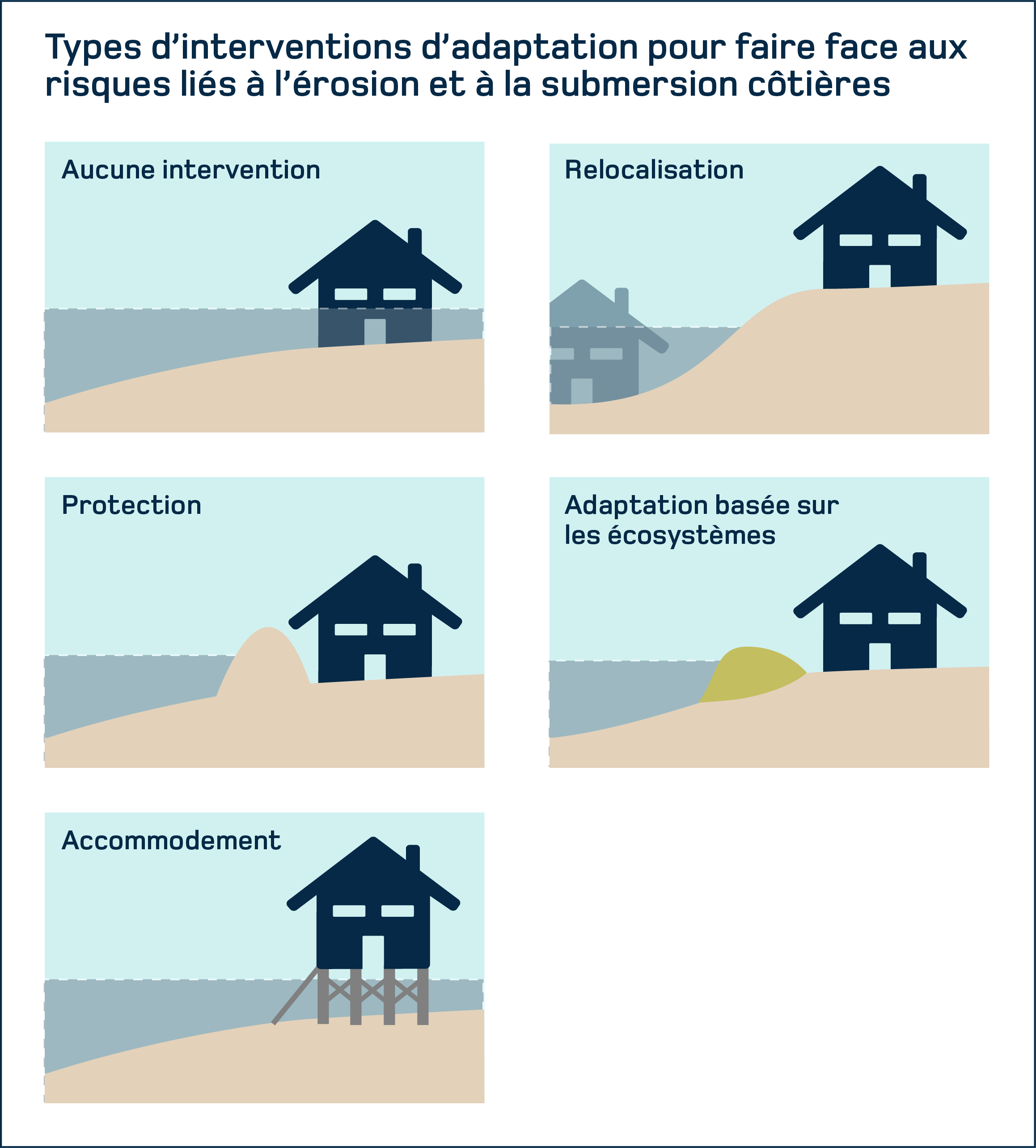Coastal erosion and submergence
Given the potential impacts of coastal erosion and submergence, adaptation is essential in order to keep communities safe, preserve infrastructure and strengthen the resilience of coastal ecosystems.
Main adaptation measures
Adaptation solutions to coastal erosion and submergence are often grouped into five main categories:

No intervention (in certain cases)
Relocation
Protection
Ecosystem-based adaptation
Accommodation
Combining measures for a more effective response
The main adaptation measures can be combined with other solutions, such as:
Conducting research in order to implement strategies that are aligned with the latest scientific data
Raising awareness to inform local populations about coastal risks and adaptation measures that have been or could be implemented
Ensuring social acceptability to encourage communities to participate and get involved
Developing methods to facilitate the implementation of effective adaptation measures
Continuously evaluating strategies to ensure that they are effective, particularly in light of future changes in the climate
Choosing adaptation measures
Various analytical methods can guide the selection of measures, such as multi-criteria analyses or cost-benefit analyses. They are used to compare the options and select the most appropriate and beneficial solution for the context. For example, cost-benefit analyses are particularly useful for estimating the relationship between the costs and benefits of each measure.
Depending on the objectives set, these methods help identify the most effective strategy for reducing the impacts of coastal erosion and submergence, while avoiding maladapted actions.
This project supports municipalities and stakeholders in their efforts to better manage coastal developments and assets over the long term, and to justify certain preventive interventions. The project also emphasizes the importance of preventive coastal risk management, which would considerably reduce the costs associated with coastal erosion.
The project to protect and rehabilitate Percé’s Anse du Sud coastline and boardwalk was born of an urgent need. Over the previous 10 years, storms had caused considerable damage to the concrete wall supporting the boardwalk, which was built in 1974. This wall, although reinforced on several occasions, was nearing the end of its useful life, threatening boardwalk access and, consequently, the local economy.
Due to this, and in the context of current and future climate change, the town of Percé questioned the effectiveness of the concrete wall. In order to make an informed decision, the municipality enlisted the help of experts to better understand the risks of coastal erosion and submergence.
Adaptation measure
After a cost-benefit analysis of various options, beach nourishment (adding fill to the beach) along with the relocation of certain buildings proved to be the most viable solution. Rehabilitation of the Percé coastline was therefore undertaken in 2017, covering a distance of over 1 km. Over 118,000 tonnes of pebbles were transported.
Factors for success
This project, which involved a several partners, was accompanied by a major climate change awareness campaign, including meetings with the public and educational tools designed to inform both residents and visitors. As well as being effective against coastal erosion and submergence, this project has been beneficial for the municipality: the coast has been beautified and has remained accessible to the population.
Natural solutions for coastal resilience
Pointe de Moisie, near Sept-Îles
An exemplary coastal restoration project has transformed a degraded site into a rich ecosystem that is also climate change resilient. Between 2016 and 2018, over 10,000 plants were planted to stabilize the soil, and paths were marked out to protect the vegetation.
Today, the area is home to thriving biodiversity, attracting wildlife and visitors alike. This project, supported by Environnement Côte-Nord, demonstrates the effectiveness of nature-based solutions for combating erosion and preserving coastal ecosystems.
Saint-André-de-Kamouraska
Coastal erosion and submergence were causing the dyke and tide gates to deteriorate, and they had to be rebuilt or relocated. The RCM of Kamouraska worked cooperatively and rallied farmland owners to consider the setting back the dyke and tide gates as the most cost-effective solution, both economically and ecologically.
The Comité ZIP du Sud-de-l’Estuaire, in collaboration with several local organizations, has relocated the dyke to allow the marsh to recolonize this former farmland. A major planting campaign has been added to this large-scale endeavour. Together, these two measures will help restore over 4 hectares of fish habitat. This project, funded by the Fonds pour la restauration côtière in 2020, is helping to preserve an environment threatened by coastal squeeze.